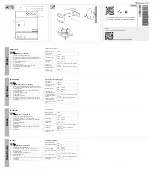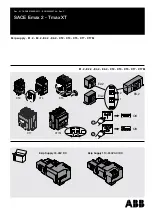
The circuit breaker operation may be checked in
"TEST" position by turning charging power switch (
l)
to
"ON" position and springs will automatically charge.
If available, close circuit breaker by local close button
and trip by local trip button. Close and trip circuit
breaker by remote control switch.
When racking circuit breaker to " CONNECTED"
position, close compartment door ( l, Fig 3) and open
sliding panel
(2).
Rotate unlocking lever ( 3) clockwise and turn racking
crank (4) approximately l I 4 turn, then release unlocking
lever. Continue cranking until racking, mechanism auto
matically stops at " CONNE CTED" position. The circuit
breaker may now be closed or tripped by remote control
switches.
MANUAL CLOSING OPERATION
The circuit breaker conditions may be observed
through sliding panel
(2,
Fig. 4) or by opening compart
ment door ( l ).
If the circuit breaker is completely uncharged, man
ually charge closing springs with manual charge lever
( 3, Fig.
2)
and pull manual close lever (4) with a lanyard
from a safe distance.
If the springs are charged, pull manual close lever (4)
with a lanyard from a safe distance.
Should closing not occur when pulling the manual close
lever (4), the closing springs may be partially charged.
Continue charging until closing springs are completely
charged (audible snap). Pull manual close lever (4) with
a lanyard from a safe distance.
CIRCUIT BREAKER REMOVAL
To remove circuit breaker from " CONNE CTED" position,
trip the breaker by the remote control switch.
Open sliding door
(2,
Fig. 3) in front compartment
door ( l ). Engage racking crank (4) and push unlocking
lever ( 3) clockwise. Rotate racking crank ( 4) counter
clockwise approximately a quarter turn, then release
unlocking lever. Continue cranking until racking mechan
ism automatically stops at "TEST" position.
Repeat same operation for "D IS CONNECT" and
"OUT" positions. Note: A charged circuit breaker will
automatically discharge during the "OUT" position. Open
compartment door and withdraw circuit breaker out of
compartment.
MAINTENANCE
These circuit breakers require minimum maintenance.
It is recommended that an established maintenance
program be set up to provide for an inspection at least
once every six months or after every l
000
operations,
whichever occurs first. After a fault operation or soofl as
possible to determine condition of contacts, arc chutes,
barriers and electrical connections.
Arc chutes which have been in service for periods of
time should be checked for any breakage or excessive
erosion to liner plates and arc chute plates.
Check jump gap area for deterioration or breakage.
Closely observe that there is no erosion or pitting of the
METAL-CLAD SWITCHGEAR
IB-2807-51
PAGE 5
rear horn spacer bushings, warped or cracked jump gap
plates and eroded disconnect pivot bolt and bushings.
Also check any erosion or distortion to front arc horn.
Remove dirt or grease from contacts with a cloth
saturated with an oil free solvent. Discoloration of main
contacts does not indicate damage. However, this condi
tion may be removed by opening and closing the circuit
breaker under no-load conditions.
Should the main contacts show slight pitting, check con
tact pressure after referring to Adjustment Section. For
manual slow close to check contact pressure, refer to
Installation Inspection Section. A moderate amount of
pitting will not interfere with the arcing contacts opera
tion. If necessary to dress arcing contacts to remove small
burrs, cover the puffer nozzle ( 3, Fig. l) with a cloth to
prevent filing entry. Follow contact contour with light
wipes of a fine file. Do not try to eliminate pitting entirely.
ADJUSTMENTS
These circuit breakers are adjusted, tested and in
spected before leaving the factory.
However, upon inspection, some changes in the contact
sequence or mechanism adjustments may be required
due to transit rough handling or abnormal conditions
after installation. We recommend circuit breakers in
stalled in switchboards be withdrawn and moved to a
suitable test area.
CONTACT PRESSURE
(See Fig. 4)
With bridge ( l) in closed position, the stationary main
contact (4) deflection should be
l
18 inch, plus or minus
1164 inch.
Make adjustments by loosening set screw
(2)
on left
pole, then close circuit breaker. Adjust left pole by turning
adjusting stud ( 3) in or out as required.
Check proper adjustment by using a 118 inch drill
(snug fit) at point "A", then securely tighten set screw
(2).
Trip circuit breaker open and partially slow close until
left pole arcing contacts just touch. Adjust the center and
right hand poles so that their arcing contacts touch at
the same time as the left hand pole arcing contacts, then
securely tighten set screw
(2).
Check center and right hand poles to insure at least
l 18 inch deflection. Make adjustments if necessary as
above.
BRIDGE PIVOT PRESSURE
(See Fig. 4)
Proper bridge pivot pressure should be made by first
loosening set screw ( 6).
While holding bridge pivot bolt head ( 5), turn in
opposite nut (7) firmly tight (approximately 7 5#) then
back out nut approximately l I 6 turn (one flat).
After making adjustments, securely tighten set screw ( 6).
OPERATING MECHANISM
The operating mechanism is adjusted at the factory
for proper operation and should not be disturbed unless
the circuit breaker does not close electrically on reclosing
duty.
www
. ElectricalPartManuals
. com




















